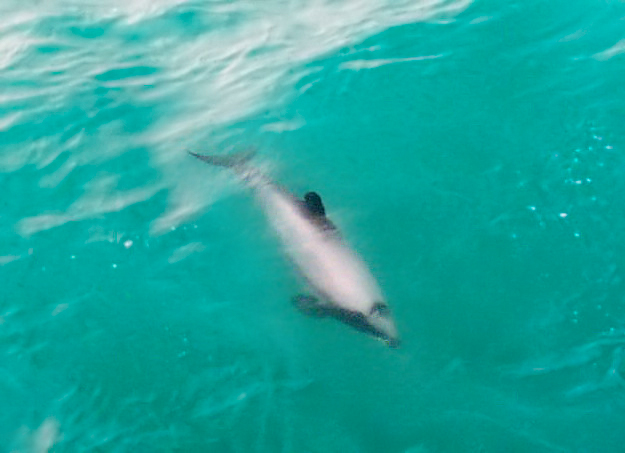ERROR : Server Busy(-1105)
ERROR : Server Busy(-1105)
Hector's Dolphin (Cephalorhynchus hectori) - Wiki
Hector's Dolphin
From Wikipedia, the free encyclopedia
[Photo] Hectors dolphin (Cephalorhynchus hectori), photographed at Kaikoura, New Zealand, february 2000. Photo by Wikipedia editor Malene Thyssen (http://commons.wikimedia.org/wiki/User:Malene). Copyright (C) Malene Thyssen
Permission is granted to copy, distribute and/or modify this document under the terms of the GNU Free Documentation License, Version 1.2 or any later version published by the Free Software Foundation; with no Invariant Sections, no Front-Cover Texts, and no Back-Cover Texts. A copy of the license is included in the section entitled "GNU Free Documentation License". |
Hector's Dolphin or White-headed Dolphin (Cephalorhynchus hectori) is the most well-known of the four dolphins in the genus Cephalorhynchus. At about 1.4 m in length, it is one of the smallest cetaceans.
Hector’s dolphin was named after Sir James Hector (1834-1907). He was the curator of the Colonial Museum in Wellington (now the Museum of New Zealand - Te Papa). He examined the first specimen found of the dolphin.
Popoto/Maui's Dolphin (Cephalorhynchus hectori maui) is a subspecies found off the northwest coast of New Zealand's North Island. It is the most endangered subspecies of all marine mammals (other cetaceans with a similarly perilous conservation status inhabit rivers and estuaries only). There are approximately 110 Maui's dolphins in the wild, with only 25 of those estimated to be breeding females. The Maui's dolphin is critically endangered due to being caught in fishing nets and being wounded by boat. Adult Maui's dolphins are generally 1.2 to 1.6 m long and weigh upto 50 kg. They have a rounded dorsal (upper) fin and have white undersides and grey sides. Maui's dolphins take short (90 second) dives to feed on small fish and crustaceans on the ocean floor.... thirty years ago there were over 26,000 Hector's and Maui's dolphins. Today, due to human activity, there is a struggling population of around 7,270 Hector's dolphins - and Maui's are the rarest marine dolphins in the world with around 110 left - WWF Apr. 2007 Physical description
Hector's dolphin has no discernible beak and a rounded dorsal fin. The fluke has pointed tips and concave trailing edges. The overall color is a pale grey but closer inspection reveals a complex tapestry of colour. The forehead is grey with streaks of black. The tip of the beak is black. The throat and chest are white. Above that there is a dark grey patch running from the flippers (also dark grey) to the eyes. The belly is also white with a stripe running up the sides from under the dorsal fin. The bulk of the back and sides is the same lighter grey of the beak. The tail stock is narrow. At birth the animal weighs about 9 kg and grows to about 40 to 60 kg at adulthood. They live for about 20 years.
Hector's dolphins live in fluid groups of about two to eight in number. They are active animals, readily bow-riding and playing with seaweed. When leaping from the sea, individuals will often land on their side, creating a loud splash (their vertical and horizontal dives are much less noisy).
Some sharks prey on Hector's Dolphins.
Population and distribution
Hector's dolphins are endemic to the coastal regions of New Zealand. There are two known main populations, one on each side of the South Island. The two populations are believed to be largely cut off from one another by deep water at Cook Strait and at the south-west tip of the South Island. The species seems unwilling or unable to cross areas of deep water. The total population was estimated to be around 3,500 in the mid-1980s. A more recent survey suggested a total population of approximately 7,250 individuals (see conservation below). A notable population exists at Akaroa, near Christchurch, New Zealand.
Hector's Dolphins are sighted always less than 10 km off-shore in summer and only slightly further afield in winter. Occasional sightings were reported from Australia and Malaysia, but these were mis-identifications.
There are about 100 individuals in the Maui subspecies.
Conservation
Entanglement in gillnets is a very significant threat to the Hector's dolphin species. From 1970 such entanglements, which lead to certain death, are estimated to be responsible for reducing the population. In 1988 a marine reserve was created around Banks Peninsula to prohibit gillnet activity in the area. This has stemmed the rate of population decrease, but an increase in numbers has not yet been recorded. Other threats, such as collisions with boat propellers, may also be hampering a return to stability.
In March 2004, New Zealand's Department of Conservation began testing a system for satellite tracking cetaceans by tagging three Hector's Dolphins. If these movements can be tracked successfully, the system will be extended to track the highly endangered Maui subspecies.
In April 2007, the World Wide Fund for Nature launched an online petition asking Helen Clark to introduce emergency measures to protect the Hector's and Maui dolphins.
http://en.wikipedia.org/wiki/Hector's_Dolphin
| The text in this page is based on the copyrighted Wikipedia article shown in above URL. It is used under the GNU Free Documentation License. You may redistribute it, verbatim or modified, providing that you comply with the terms of the GFDL. |
|

